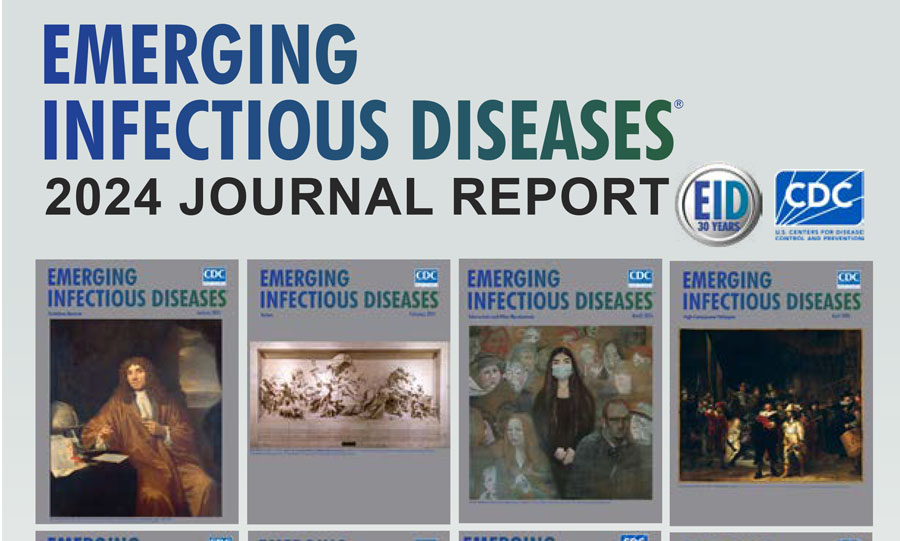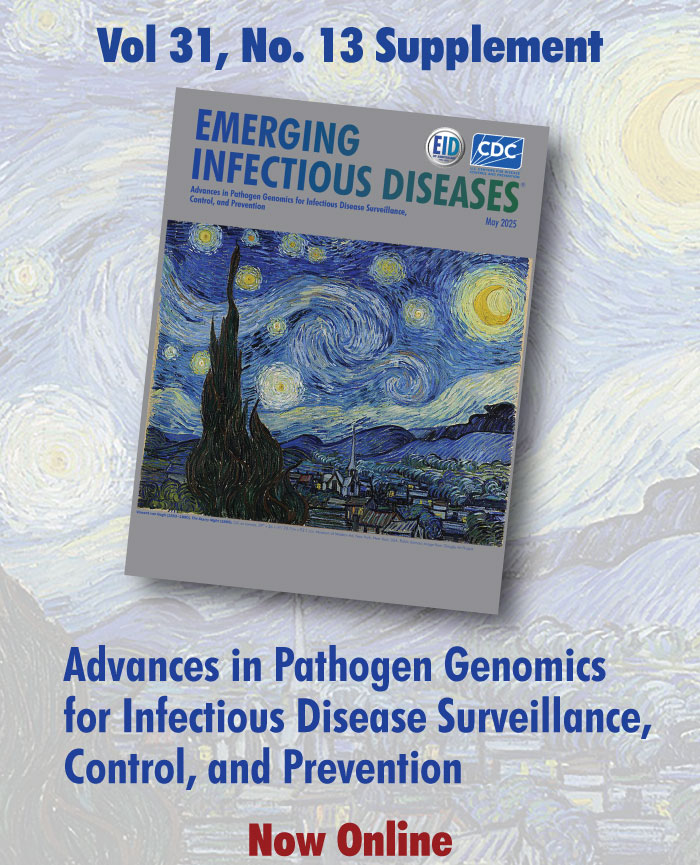Medscape CME Activity
Medscape, LLC is pleased to provide online continuing medical education (CME) for selected journal articles, allowing clinicians the opportunity to earn CME credit. In support of improving patient care, these activities have been planned and implemented by Medscape, LLC and Emerging Infectious Diseases. Medscape, LLC is jointly accredited by the Accreditation Council for Continuing Medical Education (ACCME), the Accreditation Council for Pharmacy Education (ACPE), and the American Nurses Credentialing Center (ANCC), to provide continuing education for the healthcare team.
CME credit is available for one year after publication.
Volume 30—2024
Volume 30, Number 12—December 2024
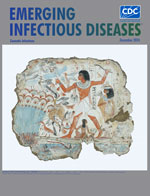
The Ebola virus disease (EVD) outbreak of 2013–2016 was large, leaving in its wake an estimated 17,000 survivors in West Africa. Uveitis is one of the most common ophthalmic manifestations of EVD, but long-term follow-up in the at-risk population is lacking. We conducted a retrospective cross-sectional study of 521 EVD survivors from Sierra Leone who underwent comprehensive ophthalmic examination a median of 1,289 days, or ≈3.5 years, after discharge from Ebola treatment units. The most common ophthalmic findings were cataracts (117 eyes, 11.2%), uveitis (86 eyes, 8.3%), dry eyes (81 eyes, 7.8%), and chorioretinal scar (68 eyes, 6.5%). EVD survivors with cataracts, uveitis, optic neuropathy, and corneal scar were more likely to have vision impairment, defined as Snellen visual acuity worse than 20/50. Results of our study highlight the need for ongoing vision care in EVD survivors.
| EID | Choo CH, Ward L, Crozier I, Fashina T, Yan D, Hayek BR, et al. Ophthalmic Sequelae of Ebola Virus Disease in Survivors, Sierra Leone. Emerg Infect Dis. 2024;30(12):2502-2509. https://doi.org/10.3201/eid3012.240425 |
|---|---|
| AMA | Choo CH, Ward L, Crozier I, et al. Ophthalmic Sequelae of Ebola Virus Disease in Survivors, Sierra Leone. Emerging Infectious Diseases. 2024;30(12):2502-2509. doi:10.3201/eid3012.240425. |
| APA | Choo, C. H., Ward, L., Crozier, I., Fashina, T., Yan, D., Hayek, B. R....Shantha, J. (2024). Ophthalmic Sequelae of Ebola Virus Disease in Survivors, Sierra Leone. Emerging Infectious Diseases, 30(12), 2502-2509. https://doi.org/10.3201/eid3012.240425. |
Volume 30, Number 11—November 2024
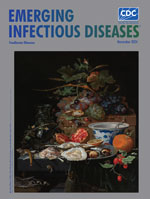
Mycobacterium abscessus infection is challenging to treat. Extrapulmonary M. abscessus infections (EP-MAB) are less common than pulmonary M. abscessus infections. To evaluate treatment regimens, we retrospectively analyzed consecutive microbiologically confirmed EP-MAB cases diagnosed in France during 2012–2020. We studied 45 patients with EP-MAB, including 14 bone and joint infections, 10 skin and soft tissue infections, and 8 lymph node infections. Most (62%) patients had no reported immunodeficiency. In 27 patients, EP-MAB followed healthcare-associated (44%) or environmental (16%) injuries. Of the 45 isolates, 25 were subspecies abscessus, 10 bolletii, and 9 massiliense; 1 was unidentified. Cure was achieved for 36 (80%) patients who received a median antimicrobial regimen of 6 months; 22 (55%) also underwent surgery. Four patients died, and 5 were unavailable for follow-up. EP-MAB predominantly affects immunocompetent patients after an injury; outcomes are favorable. We propose a >6-month regimen of antimicrobial therapy with consideration for surgery and regular patient reassessment.
| EID | Heid-Picard B, Mougari F, Pouvaret A, Lanternier F, Awad Z, Bille E, et al. Extrapulmonary Mycobacterium abscessus Infections, France, 2012–2020. Emerg Infect Dis. 2024;30(11):2294-2302. https://doi.org/10.3201/eid3011.240459 |
|---|---|
| AMA | Heid-Picard B, Mougari F, Pouvaret A, et al. Extrapulmonary Mycobacterium abscessus Infections, France, 2012–2020. Emerging Infectious Diseases. 2024;30(11):2294-2302. doi:10.3201/eid3011.240459. |
| APA | Heid-Picard, B., Mougari, F., Pouvaret, A., Lanternier, F., Awad, Z., Bille, E....Cambau, E. (2024). Extrapulmonary Mycobacterium abscessus Infections, France, 2012–2020. Emerging Infectious Diseases, 30(11), 2294-2302. https://doi.org/10.3201/eid3011.240459. |
Congregate homeless shelters are disproportionately affected by infectious disease outbreaks. We describe enterovirus epidemiology across 23 adult and family shelters in King County, Washington, USA, during October 2019–May 2021, by using repeated cross-sectional respiratory illness and environmental surveillance and viral genome sequencing. Among 3,281 participants >3 months of age, we identified coxsackievirus A21 (CVA21) in 39 adult residents (3.0% [95% CI 1.9%–4.8%] detection) across 7 shelters during October 2019–February 2020. We identified enterovirus D68 (EV-D68) in 5 adult residents in 2 shelters during October–November 2019. Of 812 environmental samples, 1 was EV-D68–positive and 5 were CVA21–positive. Other enteroviruses detected among residents, but not in environmental samples, included coxsackievirus A6/A4 in 3 children. No enteroviruses were detected during April 2020–May 2021. Phylogenetically clustered CVA21 and EV-D68 cases occurred in some shelters. Some shelters also hosted multiple CVA21 lineages.
| EID | Cox SN, Casto AM, Franko NM, Chow EJ, Han PD, Gamboa L, et al. Clinical and Genomic Epidemiology of Coxsackievirus A21 and Enterovirus D68 in Homeless Shelters, King County, Washington, USA, 2019–2021. Emerg Infect Dis. 2024;30(11):2250-2260. https://doi.org/10.3201/eid3011.240687 |
|---|---|
| AMA | Cox SN, Casto AM, Franko NM, et al. Clinical and Genomic Epidemiology of Coxsackievirus A21 and Enterovirus D68 in Homeless Shelters, King County, Washington, USA, 2019–2021. Emerging Infectious Diseases. 2024;30(11):2250-2260. doi:10.3201/eid3011.240687. |
| APA | Cox, S. N., Casto, A. M., Franko, N. M., Chow, E. J., Han, P. D., Gamboa, L....Chu, H. Y. (2024). Clinical and Genomic Epidemiology of Coxsackievirus A21 and Enterovirus D68 in Homeless Shelters, King County, Washington, USA, 2019–2021. Emerging Infectious Diseases, 30(11), 2250-2260. https://doi.org/10.3201/eid3011.240687. |
Volume 30, Number 10—October 2024
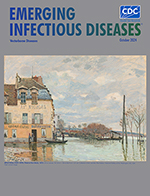
We investigated differences in risk factors and preventive behaviors by age and sex among persons with reported Lyme disease in Ontario, Canada, during 2015–2022. Incidence rates peaked among children 5–9 and adults 50–79 years of age. Median age was higher for female than male case-patients (54 vs. 51 years). Male case-patients reported more activity in wooded and tall grass areas than did female case-patients; fewer male case-patients reported sharing living space with outdoor-exposed companion animals. As age increased, more case-patients reported activity in blacklegged tick habitats, exposure to ticks, and wearing adequate clothing, but fewer reported sharing living space with outdoor-exposed companion animals. Adoption of preventive behaviors was relatively low and did not differ by sex. Male case-patients, children 5–9 years of age and their parents or caregivers, and adults >59 years of age represent populations that would benefit from tailored public health messaging on Lyme disease prevention.
| EID | Adams JA, Osasah V, Paphitis K, Danish A, Mather RG, Russell CA, et al. Age- and Sex-Specific Differences in Lyme Disease Health-Related Behaviors, Ontario, Canada, 2015–2022. Emerg Infect Dis. 2024;30(10):2006-2015. https://doi.org/10.3201/eid3010.240191 |
|---|---|
| AMA | Adams JA, Osasah V, Paphitis K, et al. Age- and Sex-Specific Differences in Lyme Disease Health-Related Behaviors, Ontario, Canada, 2015–2022. Emerging Infectious Diseases. 2024;30(10):2006-2015. doi:10.3201/eid3010.240191. |
| APA | Adams, J. A., Osasah, V., Paphitis, K., Danish, A., Mather, R. G., Russell, C. A....Nelder, M. P. (2024). Age- and Sex-Specific Differences in Lyme Disease Health-Related Behaviors, Ontario, Canada, 2015–2022. Emerging Infectious Diseases, 30(10), 2006-2015. https://doi.org/10.3201/eid3010.240191. |
Pasteurella spp. can cause fatal zoonotic infections in humans. We performed a multicenter study to investigate the prevalence and clinical features of Pasteurella infections in South Korea during 2018‒2022. We also conducted a collaborative systematic review and meta-analysis of the global burden of Pasteurella bacteremia. The study included 283 cases found an increasing trend in Pasteurella infections. Blood cultures were positive in 8/35 (22.9%) cases sampled, for overall bacteremia-associated rate of 2.8% (8/283). Aging was a significant risk factor for bacteremia (odds ratio 1.05 [95% CI 1.01–1.10]), according to multivariate analyses. For the meta-analysis, we included a total of 2,012 cases from 10 studies. The pooled prevalence of bacteremia was 12.4% (95% CI 7.3%–18.6%) and of mortality 8.4% (95% CI 2.7%–16.5%). Our findings reflect the need for greater understanding of the increase in Pasteurella infections and the global burden of Pasteurella bacteremia to determine appropriate case management.
| EID | Jeong S, Chang E, Lee N, Kim H, Kim H, Kim J, et al. Pasteurella Infections in South Korea and Systematic Review and Meta-analysis of Pasteurella Bacteremia. Emerg Infect Dis. 2024;30(10):1987-1997. https://doi.org/10.3201/eid3010.240245 |
|---|---|
| AMA | Jeong S, Chang E, Lee N, et al. Pasteurella Infections in South Korea and Systematic Review and Meta-analysis of Pasteurella Bacteremia. Emerging Infectious Diseases. 2024;30(10):1987-1997. doi:10.3201/eid3010.240245. |
| APA | Jeong, S., Chang, E., Lee, N., Kim, H., Kim, H., Kim, J....Song, W. (2024). Pasteurella Infections in South Korea and Systematic Review and Meta-analysis of Pasteurella Bacteremia. Emerging Infectious Diseases, 30(10), 1987-1997. https://doi.org/10.3201/eid3010.240245. |
Volume 30, Number 9—September 2024
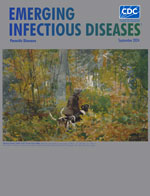
We conducted a prospective study of 159 cases of Streptococcus dysgalactiae subspecies equisimilis (SDSE) bacteremia in 157 patients at 2 hospitals in Finland during November 2015–November 2019. Cellulitis was associated with nonsevere disease (p = 0.008); necrotizing fasciitis was associated with severe disease (p = 0.004). Fifty percent of patients had >1 clinical characteristic associated with risk for death. The case-fatality rate was 6%, and 7% of patients were treated in an intensive care unit. Blood leukocyte counts on days 2 (p = 0.032) and 3 (p = 0.020) and C-reactive protein levels on days 3 (p = 0.030) and 4 (p = 0.009) after admission were predictors of severe disease. The Pitt bacteremia score was an accurate predictor of death. Using the Pitt bacteremia score, leukocyte counts, and CRP responses during initial treatment can improve treatment strategies and survival for patients with SDSE.
| EID | Nevanlinna V, Aittoniemi J, Huttunen R, Luukkaala T, Rantala S. Clinical Aspects and Disease Severity of Streptococcus dysgalactiae Subspecies equisimilis Bacteremia, Finland. Emerg Infect Dis. 2024;30(9):1770-1778. https://doi.org/10.3201/eid3009.240278 |
|---|---|
| AMA | Nevanlinna V, Aittoniemi J, Huttunen R, et al. Clinical Aspects and Disease Severity of Streptococcus dysgalactiae Subspecies equisimilis Bacteremia, Finland. Emerging Infectious Diseases. 2024;30(9):1770-1778. doi:10.3201/eid3009.240278. |
| APA | Nevanlinna, V., Aittoniemi, J., Huttunen, R., Luukkaala, T., & Rantala, S. (2024). Clinical Aspects and Disease Severity of Streptococcus dysgalactiae Subspecies equisimilis Bacteremia, Finland. Emerging Infectious Diseases, 30(9), 1770-1778. https://doi.org/10.3201/eid3009.240278. |
Evidence on mortality rates and causes of death associated with extrapulmonary nontuberculous mycobacteria (NTM) infection is limited. This nationwide register-based study in Denmark used diagnostic codes to match adult patients with extrapulmonary NTM infection 1:4 to controls. During 2000–2017, we identified 485 patients, who had significantly more comorbidities than controls. The 5-year mortality rate for patients was 26.8% (95% CI 23.1%–31.0%) and for controls, 10.9% (95% CI 9.6%–12.4%). The median age at death was 76 (interquartile range 63–85) years for patients and 84 (interquartile range 73–90) years for controls. The adjusted hazard rate of death for patients was 1.34 (95% CI 1.10–1.63; p = 0.004). Patients and controls mainly died of cardiovascular disease and solid malignant neoplasms. Hematologic malignancies and HIV were more frequently causes of death in patients. Mortality rates are substantial among patients with extrapulmonary NTM infection, predominantly caused by underlying conditions.
| EID | Pedersen AA, Dahl VN, Løkke A, Holden IK, Fløe A, Ibsen R, et al. Mortality Rate and Cause of Death in Adults with Extrapulmonary Nontuberculous Mycobacteria Infection, Denmark. Emerg Infect Dis. 2024;30(9):1790-1798. https://doi.org/10.3201/eid3009.240475 |
|---|---|
| AMA | Pedersen AA, Dahl VN, Løkke A, et al. Mortality Rate and Cause of Death in Adults with Extrapulmonary Nontuberculous Mycobacteria Infection, Denmark. Emerging Infectious Diseases. 2024;30(9):1790-1798. doi:10.3201/eid3009.240475. |
| APA | Pedersen, A. A., Dahl, V. N., Løkke, A., Holden, I. K., Fløe, A., Ibsen, R....Johansen, I. S. (2024). Mortality Rate and Cause of Death in Adults with Extrapulmonary Nontuberculous Mycobacteria Infection, Denmark. Emerging Infectious Diseases, 30(9), 1790-1798. https://doi.org/10.3201/eid3009.240475. |
Volume 30, Number 8—August 2024
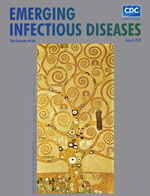
Archaea represent a separate domain of life, next to bacteria and eukarya. As components of the human microbiome, archaea have been associated with various diseases, including periodontitis, endodontic infections, small intestinal bacterial overgrowth, and urogenital tract infections. Archaea are generally considered nonpathogenic; the reasons are speculative because of limited knowledge and gene annotation challenges. Nevertheless, archaeal syntrophic principles that shape global microbial networks aid both archaea and potentially pathogenic bacteria. Evaluating archaea interactions remains challenging, requiring clinical studies on inflammatory potential and the effects of archaeal metabolism. Establishing a culture collection is crucial for investigating archaea functions within the human microbiome, which could improve health outcomes in infectious diseases. We summarize potential reasons for archaeal nonpathogenicity, assess the association with infectious diseases in humans, and discuss the necessary experimental steps to enable mechanistic studies involving archaea.
| EID | Duller S, Moissl-Eichinger C. Archaea in the Human Microbiome and Potential Effects on Human Infectious Disease. Emerg Infect Dis. 2024;30(8):1505-1513. https://doi.org/10.3201/eid3008.240181 |
|---|---|
| AMA | Duller S, Moissl-Eichinger C. Archaea in the Human Microbiome and Potential Effects on Human Infectious Disease. Emerging Infectious Diseases. 2024;30(8):1505-1513. doi:10.3201/eid3008.240181. |
| APA | Duller, S., & Moissl-Eichinger, C. (2024). Archaea in the Human Microbiome and Potential Effects on Human Infectious Disease. Emerging Infectious Diseases, 30(8), 1505-1513. https://doi.org/10.3201/eid3008.240181. |
Human infections with Corynebacterium diphtheriae species complex (CdSC) bacteria were rare in French Guiana until 2016, when the number of cases diagnosed increased. We conducted an epidemiologic, multicenter, retrospective study of all human CdSC infections diagnosed in French Guiana during January 1, 2016–December 31, 2021. A total of 64 infectious episodes were observed in 60 patients; 61 infections were caused by C. diphtheriae and 3 by C. ulcerans. Estimated incidence increased from 0.7 cases/100,000 population in 2016 to 7.7 cases/100,000 population in 2021. The mean patient age was 30.4 (+23.7) years, and male-to-female ratio was 1.7:1 (38/22). Of the 61 C. diphtheriae isolates, 5 tested positive for the diphtheria toxin gene, and all results were negative by Elek test; 95% (61/64) of cases were cutaneous, including the C. ulcerans cases. The increase in reported human infections underscores the need to raise awareness among frontline healthcare practitioners to improve prevention.
| EID | Gaillet M, Hennart M, Rose V, Badell E, Michaud C, Blaizot R, et al. Retrospective Study of Infections with Corynebacterium diphtheriae Species Complex, French Guiana, 2016–2021. Emerg Infect Dis. 2024;30(8):1545-1554. https://doi.org/10.3201/eid3008.231671 |
|---|---|
| AMA | Gaillet M, Hennart M, Rose V, et al. Retrospective Study of Infections with Corynebacterium diphtheriae Species Complex, French Guiana, 2016–2021. Emerging Infectious Diseases. 2024;30(8):1545-1554. doi:10.3201/eid3008.231671. |
| APA | Gaillet, M., Hennart, M., Rose, V., Badell, E., Michaud, C., Blaizot, R....Brisse, S. (2024). Retrospective Study of Infections with Corynebacterium diphtheriae Species Complex, French Guiana, 2016–2021. Emerging Infectious Diseases, 30(8), 1545-1554. https://doi.org/10.3201/eid3008.231671. |
Volume 30, Number 7—July 2024
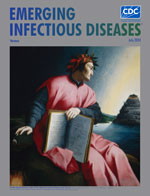
Xenotransplantation, transplantation into humans of vascularized organs or viable cells from nonhuman species, is a potential solution to shortages of transplantable human organs. Among challenges to application of clinical xenotransplantation are unknown risks of transmission of animal microbes to immunosuppressed recipients or the community. Experience in allotransplantation and in preclinical models suggests that viral infections are the greatest concern. Worldwide, the distribution of swine pathogens is heterogeneous and cannot be fully controlled by international agricultural regulations. It is possible to screen source animals for potential human pathogens before procuring organs in a manner not possible within the time available for surveillance testing in allotransplantation. Infection control measures require microbiological assays for surveillance of source animals and xenograft recipients and research into zoonotic potential of porcine organisms. Available data suggest that infectious risks of xenotransplantation are manageable and that clinical trials can advance with appropriate protocols for microbiological monitoring of source animals and recipients.
| EID | Fishman JA, Mueller NJ. Infectious Diseases and Clinical Xenotransplantation. Emerg Infect Dis. 2024;30(7):1311-1318. https://doi.org/10.3201/eid3007.240273 |
|---|---|
| AMA | Fishman JA, Mueller NJ. Infectious Diseases and Clinical Xenotransplantation. Emerging Infectious Diseases. 2024;30(7):1311-1318. doi:10.3201/eid3007.240273. |
| APA | Fishman, J. A., & Mueller, N. J. (2024). Infectious Diseases and Clinical Xenotransplantation. Emerging Infectious Diseases, 30(7), 1311-1318. https://doi.org/10.3201/eid3007.240273. |
Volume 30, Number 6—June 2024
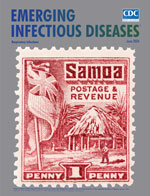
We conducted surveillance for carbapenem-resistant Enterobacterales (CRE) during 2016–2020 at 10 US sites and extended-spectrum β-lactamase–producing Enterobacterales (ESBL-E) during 2019–2020 at 6 US sites. Among 159 CRE cases in children (median age 5 years), CRE was isolated from urine for 131 (82.4%) and blood from 20 (12.6%). Annual CRE incidence rate (cases/100,000 population) was 0.47–0.87. Among 207 ESBL-E cases in children (median age 6 years), ESBL-E was isolated from urine of 196 (94.7%) and blood of 8 (3.9%). Annual ESBL-E incidence rate was 26.5 in 2019 and 19.63 in 2020. CRE and ESBL-E rates were >2-fold higher among infants than other age groups. Most CRE and ESBL-E cases were healthcare-associated community-onset (68 [43.0%] for CRE vs. 40 [23.7%] for ESBL-E) or community-associated (43 [27.2%] for CRE vs. 109 [64.5%] for ESBL-E). Programs to detect, prevent, and treat multidrug-resistant infections must include pediatric populations (particularly the youngest) and outpatient settings.
| EID | Grome HN, Grass JE, Duffy N, Bulens SN, Ansari U, Campbell D, et al. Carbapenem-Resistant and Extended-Spectrum β-Lactamase–Producing Enterobacterales in Children, United States, 2016–2020. Emerg Infect Dis. 2024;30(6):1104-1114. https://doi.org/10.3201/eid3006.231734 |
|---|---|
| AMA | Grome HN, Grass JE, Duffy N, et al. Carbapenem-Resistant and Extended-Spectrum β-Lactamase–Producing Enterobacterales in Children, United States, 2016–2020. Emerging Infectious Diseases. 2024;30(6):1104-1114. doi:10.3201/eid3006.231734. |
| APA | Grome, H. N., Grass, J. E., Duffy, N., Bulens, S. N., Ansari, U., Campbell, D....Guh, A. Y. (2024). Carbapenem-Resistant and Extended-Spectrum β-Lactamase–Producing Enterobacterales in Children, United States, 2016–2020. Emerging Infectious Diseases, 30(6), 1104-1114. https://doi.org/10.3201/eid3006.231734. |
Volume 30, Number 5—May 2024
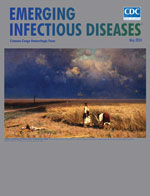
Crimean-Congo hemorrhagic fever (CCHF) is a tickborne infection that can range from asymptomatic to fatal and has been described in >30 countries. Early identification and isolation of patients with suspected or confirmed CCHF and the use of appropriate prevention and control measures are essential for preventing human-to-human transmission. Here, we provide an overview of the epidemiology, clinical features, and prevention and control of CCHF. CCHF poses a continued public health threat given its wide geographic distribution, potential to spread to new regions, propensity for genetic variability, and potential for severe and fatal illness, in addition to the limited medical countermeasures for prophylaxis and treatment. A high index of suspicion, comprehensive travel and epidemiologic history, and clinical evaluation are essential for prompt diagnosis. Infection control measures can be effective in reducing the risk for transmission but require correct and consistent application.
| EID | Frank MG, Weaver G, Raabe V. Crimean-Congo Hemorrhagic Fever Virus for Clinicians—Epidemiology, Clinical Manifestations, and Prevention. Emerg Infect Dis. 2024;30(5):854-863. https://doi.org/10.3201/eid3005.231647 |
|---|---|
| AMA | Frank MG, Weaver G, Raabe V. Crimean-Congo Hemorrhagic Fever Virus for Clinicians—Epidemiology, Clinical Manifestations, and Prevention. Emerging Infectious Diseases. 2024;30(5):854-863. doi:10.3201/eid3005.231647. |
| APA | Frank, M. G., Weaver, G., & Raabe, V. (2024). Crimean-Congo Hemorrhagic Fever Virus for Clinicians—Epidemiology, Clinical Manifestations, and Prevention. Emerging Infectious Diseases, 30(5), 854-863. https://doi.org/10.3201/eid3005.231647. |
Crimean-Congo hemorrhagic fever virus (CCHFV) is the most geographically widespread tickborne viral infection worldwide and has a fatality rate of up to 62%. Despite its widespread range and high fatality rate, no vaccines or treatments are currently approved by regulatory agencies in the United States or Europe. Supportive treatment remains the standard of care, but the use of antiviral medications developed for other viral infections have been considered. We reviewed published literature to summarize the main aspects of CCHFV infection in humans. We provide an overview of diagnostic testing and management and medical countermeasures, including investigational vaccines and limited therapeutics. CCHFV continues to pose a public health threat because of its wide geographic distribution, potential to spread to new regions, propensity for genetic variability, potential for severe and fatal illness, and limited medical countermeasures for prophylaxis and treatment. Clinicians should become familiar with available diagnostic and management tools for CCHFV infections in humans.
| EID | Frank MG, Weaver G, Raabe V. Crimean-Congo Hemorrhagic Fever Virus for Clinicians—Diagnosis, Clinical Management, and Therapeutics. Emerg Infect Dis. 2024;30(5):864-873. https://doi.org/10.3201/eid3005.231648 |
|---|---|
| AMA | Frank MG, Weaver G, Raabe V. Crimean-Congo Hemorrhagic Fever Virus for Clinicians—Diagnosis, Clinical Management, and Therapeutics. Emerging Infectious Diseases. 2024;30(5):864-873. doi:10.3201/eid3005.231648. |
| APA | Frank, M. G., Weaver, G., & Raabe, V. (2024). Crimean-Congo Hemorrhagic Fever Virus for Clinicians—Diagnosis, Clinical Management, and Therapeutics. Emerging Infectious Diseases, 30(5), 864-873. https://doi.org/10.3201/eid3005.231648. |
Volume 30, Number 4—April 2024
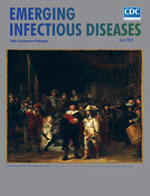
In 2022, concurrent outbreaks of hepatitis A, invasive meningococcal disease (IMD), and mpox were identified in Florida, USA, primarily among men who have sex with men. The hepatitis A outbreak (153 cases) was associated with hepatitis A virus genotype IA. The IMD outbreak (44 cases) was associated with Neisseria meningitidis serogroup C, sequence type 11, clonal complex 11. The mpox outbreak in Florida (2,845 cases) was part of a global epidemic. The hepatitis A and IMD outbreaks were concentrated in Central Florida and peaked during March–June, whereas mpox cases were more heavily concentrated in South Florida and had peak incidence in August. HIV infection was more common (52%) among mpox cases than among hepatitis A (21%) or IMD (34%) cases. Where feasible, vaccination against hepatitis A, meningococcal disease, and mpox should be encouraged among at-risk groups and offered along with program services that target those groups.
| EID | Doyle TJ, Gumke M, Stanek D, Moore J, Buck B, Locksmith T, et al. Concurrent Outbreaks of Hepatitis A, Invasive Meningococcal Disease, and Mpox, Florida, USA, 2021–2022. Emerg Infect Dis. 2024;30(4):634-643. https://doi.org/10.3201/eid3004.231392 |
|---|---|
| AMA | Doyle TJ, Gumke M, Stanek D, et al. Concurrent Outbreaks of Hepatitis A, Invasive Meningococcal Disease, and Mpox, Florida, USA, 2021–2022. Emerging Infectious Diseases. 2024;30(4):634-643. doi:10.3201/eid3004.231392. |
| APA | Doyle, T. J., Gumke, M., Stanek, D., Moore, J., Buck, B., Locksmith, T....Chacreton, D. (2024). Concurrent Outbreaks of Hepatitis A, Invasive Meningococcal Disease, and Mpox, Florida, USA, 2021–2022. Emerging Infectious Diseases, 30(4), 634-643. https://doi.org/10.3201/eid3004.231392. |
During October 2021–June 2023, a total of 392 cases of acute hepatitis of unknown etiology in children in the United States were reported to Centers for Disease Control and Prevention as part of national surveillance. We describe demographic and clinical characteristics, including potential involvement of adenovirus in development of acute hepatitis, of 8 fatally ill children who met reporting criteria. The children had diverse courses of illness. Two children were immunocompromised when initially brought for care. Four children tested positive for adenovirus in multiple specimen types, including 2 for whom typing was completed. One adenovirus-positive child had no known underlying conditions, supporting a potential relationship between adenovirus and acute hepatitis in previously healthy children. Our findings emphasize the importance of continued investigation to determine the mechanism of liver injury and appropriate treatment. Testing for adenovirus in similar cases could elucidate the role of the virus.
| EID | Almendares O, Baker JM, Sugerman DE, Parashar UD, Reagan-Steiner S, Kirking HL, et al. Deaths Associated with Pediatric Hepatitis of Unknown Etiology, United States, October 2021–June 2023. Emerg Infect Dis. 2024;30(4):644-653. https://doi.org/10.3201/eid3004.231140 |
|---|---|
| AMA | Almendares O, Baker JM, Sugerman DE, et al. Deaths Associated with Pediatric Hepatitis of Unknown Etiology, United States, October 2021–June 2023. Emerging Infectious Diseases. 2024;30(4):644-653. doi:10.3201/eid3004.231140. |
| APA | Almendares, O., Baker, J. M., Sugerman, D. E., Parashar, U. D., Reagan-Steiner, S., Kirking, H. L....Tate, J. E. (2024). Deaths Associated with Pediatric Hepatitis of Unknown Etiology, United States, October 2021–June 2023. Emerging Infectious Diseases, 30(4), 644-653. https://doi.org/10.3201/eid3004.231140. |
Volume 30, Number 3—March 2024
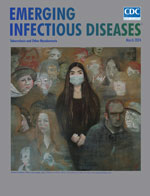
Streptococcus suis, a zoonotic bacterial pathogen circulated through swine, can cause severe infections in humans. Because human S. suis infections are not notifiable in most countries, incidence is underestimated. We aimed to increase insight into the molecular epidemiology of human S. suis infections in Europe. To procure data, we surveyed 7 reference laboratories and performed a systematic review of the scientific literature. We identified 236 cases of human S. suis infection from those sources and an additional 87 by scanning gray literature. We performed whole-genome sequencing to type 46 zoonotic S. suis isolates and combined them with 28 publicly available genomes in a core-genome phylogeny. Clonal complex (CC) 1 isolates accounted for 87% of typed human infections; CC20, CC25, CC87, and CC94 also caused infections. Emergence of diverse zoonotic clades and notable severity of illness in humans support classifying S. suis infection as a notifiable condition.
| EID | Brizuela J, Roodsant TJ, Hasnoe Q, van der Putten B, Kozakova J, Slotved H, et al. Molecular Epidemiology of Underreported Emerging Zoonotic Pathogen Streptococcus suis in Europe. Emerg Infect Dis. 2024;30(3):413-422. https://doi.org/10.3201/eid3003.230348 |
|---|---|
| AMA | Brizuela J, Roodsant TJ, Hasnoe Q, et al. Molecular Epidemiology of Underreported Emerging Zoonotic Pathogen Streptococcus suis in Europe. Emerging Infectious Diseases. 2024;30(3):413-422. doi:10.3201/eid3003.230348. |
| APA | Brizuela, J., Roodsant, T. J., Hasnoe, Q., van der Putten, B., Kozakova, J., Slotved, H....Schultsz, C. (2024). Molecular Epidemiology of Underreported Emerging Zoonotic Pathogen Streptococcus suis in Europe. Emerging Infectious Diseases, 30(3), 413-422. https://doi.org/10.3201/eid3003.230348. |
Disseminated leishmaniasis (DL) is an emergent severe disease manifesting with multiple lesions. To determine the relationship between immune response and clinical and therapeutic outcomes, we studied 101 DL and 101 cutaneous leishmaniasis (CL) cases and determined cytokines and chemokines in supernatants of mononuclear cells stimulated with leishmania antigen. Patients were treated with meglumine antimoniate (20 mg/kg) for 20 days (CL) or 30 days (DL); 19 DL patients were instead treated with amphotericin B, miltefosine, or miltefosine and meglumine antimoniate. High levels of chemokine ligand 9 were associated with more severe DL. The cure rate for meglumine antimoniate was low for both DL (44%) and CL (60%), but healing time was longer in DL (p = 0.003). The lowest cure rate (22%) was found in DL patients with >100 lesions. However, meglumine antimoniate/miltefosine treatment cured all DL patients who received it; therefore, that combination should be considered as first choice therapy.
| EID | Machado P, Lago A, Cardoso TM, Magalhaes A, Carvalho LP, Lago T, et al. Disseminated Leishmaniasis, a Severe Form of Leishmania braziliensis Infection. Emerg Infect Dis. 2024;30(3):510-518. https://doi.org/10.3201/eid3003.230786 |
|---|---|
| AMA | Machado P, Lago A, Cardoso TM, et al. Disseminated Leishmaniasis, a Severe Form of Leishmania braziliensis Infection. Emerging Infectious Diseases. 2024;30(3):510-518. doi:10.3201/eid3003.230786. |
| APA | Machado, P., Lago, A., Cardoso, T. M., Magalhaes, A., Carvalho, L. P., Lago, T....Carvalho, E. M. (2024). Disseminated Leishmaniasis, a Severe Form of Leishmania braziliensis Infection. Emerging Infectious Diseases, 30(3), 510-518. https://doi.org/10.3201/eid3003.230786. |
Volume 30, Number 2—February 2024
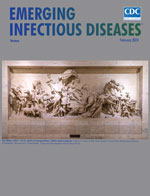
Invasive fusariosis can be life-threatening, especially in immunocompromised patients who require intensive care unit (ICU) admission. We conducted a multicenter retrospective study to describe clinical and biologic characteristics, patient outcomes, and factors associated with death and response to antifungal therapy. We identified 55 patients with invasive fusariosis from 16 ICUs in France during 2002–2020. The mortality rate was high (56%). Fusariosis-related pneumonia occurred in 76% of patients, often leading to acute respiratory failure. Factors associated with death included elevated sequential organ failure assessment score at ICU admission or history of allogeneic hematopoietic stem cell transplantation or hematologic malignancies. Neither voriconazole treatment nor disseminated fusariosis were strongly associated with response to therapy. Invasive fusariosis can lead to multiorgan failure and is associated with high mortality rates in ICUs. Clinicians should closely monitor ICU patients with a history of hematologic malignancies or stem cell transplantation because of higher risk for death.
| EID | Demonchy J, Biard L, Clere-Jehl R, Wallet F, Mokart D, Moreau A, et al. Multicenter Retrospective Study of Invasive Fusariosis in Intensive Care Units, France. Emerg Infect Dis. 2024;30(2):215-224. https://doi.org/10.3201/eid3002.231221 |
|---|---|
| AMA | Demonchy J, Biard L, Clere-Jehl R, et al. Multicenter Retrospective Study of Invasive Fusariosis in Intensive Care Units, France. Emerging Infectious Diseases. 2024;30(2):215-224. doi:10.3201/eid3002.231221. |
| APA | Demonchy, J., Biard, L., Clere-Jehl, R., Wallet, F., Mokart, D., Moreau, A....Zafrani, L. (2024). Multicenter Retrospective Study of Invasive Fusariosis in Intensive Care Units, France. Emerging Infectious Diseases, 30(2), 215-224. https://doi.org/10.3201/eid3002.231221. |
During January–August 2021, the Community Prevalence of SARS-CoV-2 Study used time/location sampling to recruit a cross-sectional, population-based cohort to estimate SARS-CoV-2 seroprevalence and nasal swab sample PCR positivity across 15 US communities. Survey-weighted estimates of SARS-CoV-2 infection and vaccine willingness among participants at each site were compared within demographic groups by using linear regression models with inverse variance weighting. Among 22,284 persons >2 months of age and older, median prevalence of infection (prior, active, or both) was 12.9% across sites and similar across age groups. Within each site, average prevalence of infection was 3 percentage points higher for Black than White persons and average vaccine willingness was 10 percentage points lower for Black than White persons and 7 percentage points lower for Black persons than for persons in other racial groups. The higher prevalence of SARS-CoV-2 infection among groups with lower vaccine willingness highlights the disparate effect of COVID-19 and its complications.
| EID | Justman J, Skalland T, Moore A, Amos CI, Marzinke MA, Zangeneh SZ, et al. Prevalence of SARS-CoV-2 Infection among Children and Adults in 15 US Communities, 2021. Emerg Infect Dis. 2024;30(2):245-254. https://doi.org/10.3201/eid3002.230863 |
|---|---|
| AMA | Justman J, Skalland T, Moore A, et al. Prevalence of SARS-CoV-2 Infection among Children and Adults in 15 US Communities, 2021. Emerging Infectious Diseases. 2024;30(2):245-254. doi:10.3201/eid3002.230863. |
| APA | Justman, J., Skalland, T., Moore, A., Amos, C. I., Marzinke, M. A., Zangeneh, S. Z....Ahmed, S. (2024). Prevalence of SARS-CoV-2 Infection among Children and Adults in 15 US Communities, 2021. Emerging Infectious Diseases, 30(2), 245-254. https://doi.org/10.3201/eid3002.230863. |
Volume 30, Number 1—January 2024

We describe detection of the previously rarely reported gram-positive bacterium Auritidibacter ignavus in 3 cases of chronic ear infections in Germany. In all 3 cases, the patients had refractory otorrhea. Although their additional symptoms varied, all patients had an ear canal stenosis and A. ignavus detected in microbiologic swab specimens. A correct identification of A. ignavus in the clinical microbiology laboratory is hampered by the inability to identify it by using matrix-assisted laser desorption/ionization time-of-flight mass spectrometry. Also, the bacterium might easily be overlooked because of its morphologic similarity to bacterial species of the resident skin flora. We conclude that a high index of suspicion is warranted to identify A. ignavus and that it should be particularly considered in patients with chronic external otitis who do not respond clinically to quinolone ear drop therapy.
| EID | Roth S, Linxweiler M, Rehner J, Schmartz G, Becker SL, Kühn J. Auritidibacter ignavus, an Emerging Pathogen Associated with Chronic Ear Infections. Emerg Infect Dis. 2024;30(1):8-12. https://doi.org/10.3201/eid3001.230385 |
|---|---|
| AMA | Roth S, Linxweiler M, Rehner J, et al. Auritidibacter ignavus, an Emerging Pathogen Associated with Chronic Ear Infections. Emerging Infectious Diseases. 2024;30(1):8-12. doi:10.3201/eid3001.230385. |
| APA | Roth, S., Linxweiler, M., Rehner, J., Schmartz, G., Becker, S. L., & Kühn, J. (2024). Auritidibacter ignavus, an Emerging Pathogen Associated with Chronic Ear Infections. Emerging Infectious Diseases, 30(1), 8-12. https://doi.org/10.3201/eid3001.230385. |
Using whole-genome sequencing, we characterized Escherichia coli strains causing early-onset sepsis (EOS) in 32 neonatal cases from a 2019–2021 prospective multicenter study in France and compared them to E. coli strains collected from vaginal swab specimens from women in third-trimester gestation. We observed no major differences in phylogenetic groups or virulence profiles between the 2 collections. However, sequence type (ST) analysis showed the presence of 6/32 (19%) ST1193 strains causing EOS, the same frequency as in the highly virulent clonal group ST95. Three ST1193 strains caused meningitis, and 3 harbored extended-spectrum β-lactamase. No ST1193 strains were isolated from vaginal swab specimens. Emerging ST1193 appears to be highly prevalent, virulent, and antimicrobial resistant in neonates. However, the physiopathology of EOS caused by ST1193 has not yet been elucidated. Clinicians should be aware of the possible presence of E. coli ST1193 in prenatal and neonatal contexts and provide appropriate monitoring and treatment.
| EID | Malaure C, Geslain G, Birgy A, Bidet P, Poilane I, Allain M, et al. Early-Onset Infection Caused by Escherichia coli Sequence Type 1193 in Late Preterm and Full-Term Neonates. Emerg Infect Dis. 2024;30(1):20-28. https://doi.org/10.3201/eid3001.230851 |
|---|---|
| AMA | Malaure C, Geslain G, Birgy A, et al. Early-Onset Infection Caused by Escherichia coli Sequence Type 1193 in Late Preterm and Full-Term Neonates. Emerging Infectious Diseases. 2024;30(1):20-28. doi:10.3201/eid3001.230851. |
| APA | Malaure, C., Geslain, G., Birgy, A., Bidet, P., Poilane, I., Allain, M....Bonacorsi, S. (2024). Early-Onset Infection Caused by Escherichia coli Sequence Type 1193 in Late Preterm and Full-Term Neonates. Emerging Infectious Diseases, 30(1), 20-28. https://doi.org/10.3201/eid3001.230851. |
CME Articles by Volume
